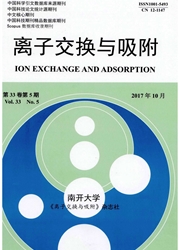

 中文摘要:
中文摘要:
选用聚丙烯酸系D730、FPA98和聚(苯乙烯-二乙烯苯)系的D201强碱型阴离子交换树脂作为吸附剂,系统研究单宁酸、五倍子酸在上述3种阴离子交换树脂上的吸附行为与机理。吸附等温线表明,聚丙烯酸系阴离子交换树脂对单宁酸的吸附性能优于聚苯乙烯-二乙烯苯系阴离子交换树脂,而聚(苯乙烯-二乙烯苯)系阴离子交换树脂对五倍子酸有较高的吸附容量。虽然3种阴离子交换树脂对单宁酸的吸附均为熵推动的自发吸附过程,静电引力是主要吸附作用力,但是在吸附过程中除离子交换作用外,D730和FPA98骨架上的羰基与单宁酸有较强的氢键作用,而D201骨架上的苯环与五倍子酸也存在着“π-π”共轭作用,从而提升离子交换树脂对鞣酸类物质的吸附性能。因此,影响离子交换树脂吸附性能的不仅是交换容量,其骨架结构对吸附性能也有较大影响。另外,上述吸附作用也会影响树脂吸附饱和后的脱附性能,相比较聚(苯乙烯-二乙烯苯)系强碱型阴离子交换树脂,聚丙烯酸系强碱型阴离子交换树脂有更好脱附性能。
 英文摘要:
英文摘要:
In this paper, adsorption of tannic acid and gallic acid by anion exchange resins of D201, FPA98 and D730 with different skeleton structure was systematically investigated. Compared with polystyrene-type anion exchange resin, higher adsorption capacity of tannic acid by polyacrylic-type anion exchange resins was observed. However, polystyrene-type anion exchange resin of D201 showed higher adsorption capacity of gallic acid. Based on the values of enthalpy changes, the adsorption of tannic acid and gallic acid on three kinds of anion exchange resins was an entropy-driven endothermic process, and the electric attraction was the main force of adsorption. Besides ion-exchange groups, carbonyl groups on FPA98 and D730 were important adsorption sites for adsorption of tannic acids. Furthermore, the strong z-n conjugation existed between D201 and gallic acid was helpful to adsorption. Thus, the skeleton structure of anion exchange resins made influence on adsorption capacity. However, the z-n conjugation and hydrogen bond between anion exchange resins and natural organic acid had an adverse effect on the desorption capacity. Compared with polystyrene-type anion exchange resins, polyacrylic-type anion exchange resins showed higher desorption capacity of tannic acid and gallic acid.
 同期刊论文项目
同期刊论文项目
 同项目期刊论文
同项目期刊论文
 期刊信息
期刊信息
